Disclosure: This post may contain affiliate links. I may earn a small commission for my endorsement, recommendation, testimonial, and/or link to any products or services from this website.
Yes, you can enjoy a crusty loaf of French baguette at home — even if you’re not in Paris! The best baguette recipe includes all of the tips and tricks you’ll need for a perfect, golden brown loaf of French bread every single time. Use the crusty, chewy bread for sandwiches, alongside bowls of soup, or with your next pasta dinner!
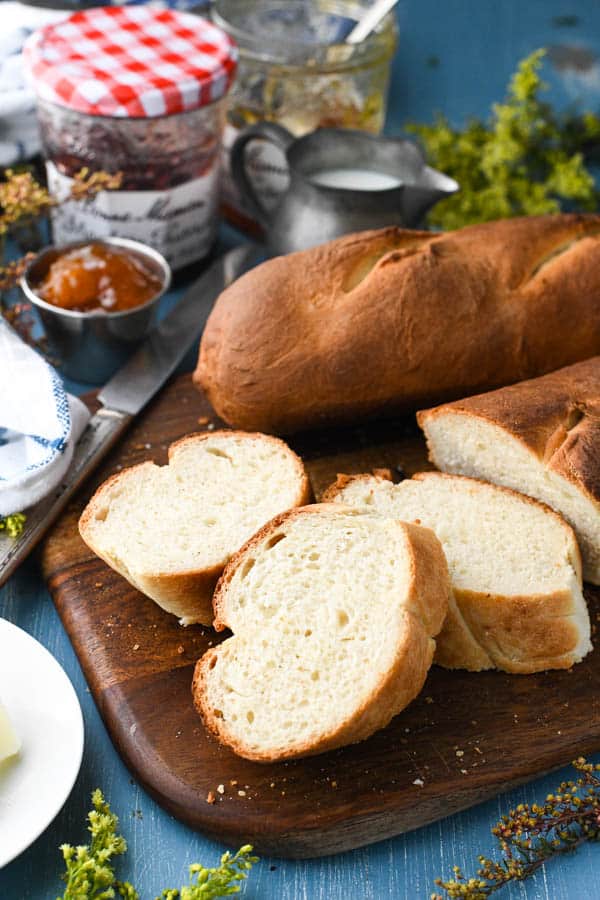
Table of Contents
- Easy Homemade French Baguette
- What is a Baguette?
- Ingredients for an Easy Baguette Recipe
- How to Make Baguettes
- How to Knead Bread Dough
- How to Proof Bread Dough
- How to Shape Baguettes
- Serving Suggestions: How to Eat French Baguette
- How to Keep Homemade Baguettes Fresh: Storage & Reheating
- Tips for the Best Baguette Recipe
- Homemade Baguette Recipe
Easy Homemade French Baguette
When I was growing up, my mom did most of the day-to-day cooking in our house — but my dad was in charge of the bread. From biscuits to baguettes, he has mastered the science of bread-baking. Of course, I consulted Granddaddy when I decided to learn the art of the French baguette myself.
My goal was to create an easy French baguette recipe with a crisp crust and light, airy center — while keeping the process approachable and manageable — even for beginner bread-bakers. Because let’s be honest: very few of us have the time (or desire) to work on a loaf of bread for an entire day, and very few of us will devote our lives to creating authentic artisan French baguettes in a boulangerie. Instead, what you get here is a really simple process that yields two very delicious loaves of bread!
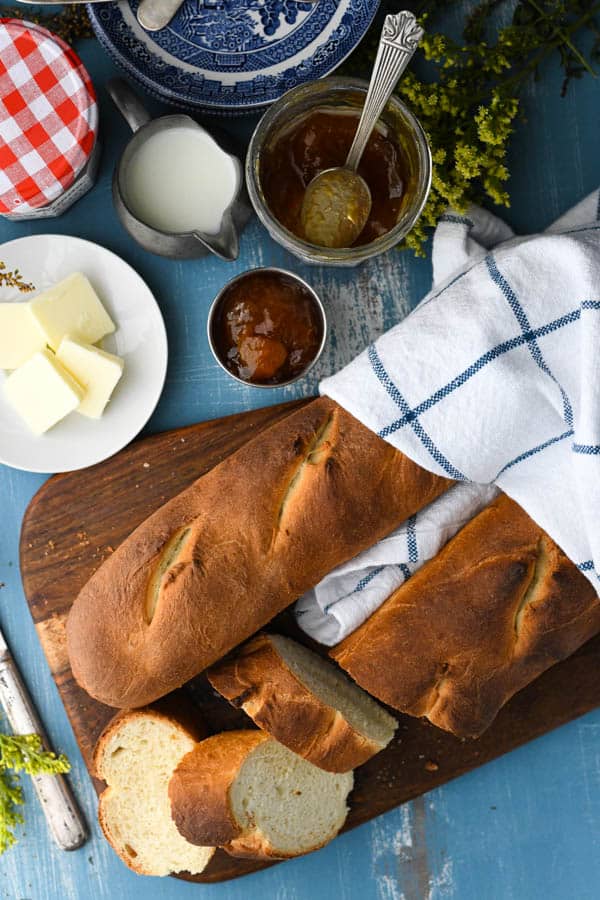
What is a Baguette?
A baguette is a long, thin loaf of French bread that’s made with a lean dough. It’s distinguished by its shape and its crisp crust. The word baguette simply means “wand,” “baton,” or “stick” — obviously referring to the bread’s long, thin shape.
Authentic French baguette recipes have a reputation for being some of the hardest homemade breads to achieve. Artisan-style loaves are usually made with a pre-ferment called a poolish, which increases the flavor complexity of the bread and may include whole wheat flour and other grains such as rye. These loaves require a significant amount of time to rest and rise and can be quite tedious to master. As I mentioned above, this particular French bread recipe is an easy version that’s perfect for beginners. I’ll walk you step-by-step through the process, which is fairly quick and only requires 5 basic ingredients.
What’s the difference between French bread and a baguette?
A traditional French bread loaf is much wider than a baguette, and has a softer crust, making it ideal for recipes like toasted appetizers or garlic bread. Baguettes are long and thin with a thicker crust. You can use French bread to make sandwiches, French toast, or flatbreads like a French bread pizza. Since baguettes are more narrow, they’re great for more bite-sized recipes like crostinis and bruschetta. Slice them into small slices and toast them up for the perfect dippable chip, or cube up a day-old baguette and use it for bread pudding or homemade croutons.
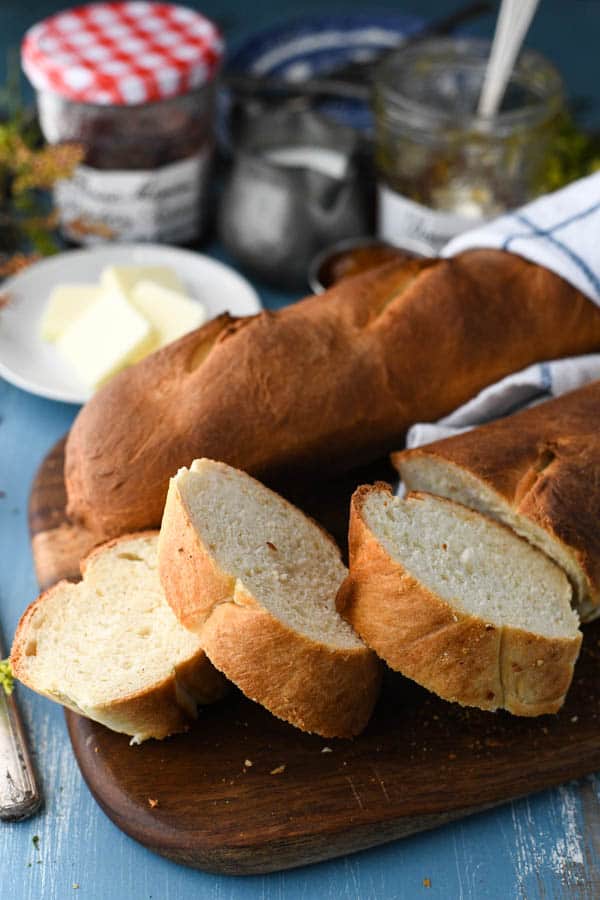
Ingredients for an Easy Baguette Recipe
This is just a quick overview of the simple ingredients that you’ll need for a homemade baguette. As always, specific measurements and complete cooking instructions are included in the printable recipe box at the bottom of the post.
- Dry active yeast: helps the dough rise.
- Lukewarm water: activates the yeast.
- Sugar: feeds the yeast.
- All-purpose flour: while I typically prefer bread flour in homemade bread, the baguette recipe works best with all-purpose flour. All-purpose flour is a blend of hard and soft wheat and is wonderful for making airier (less chewy) bread, like baguettes.
- Salt: enhances the other flavors in the bread.
- Cornmeal for dusting, optional: helps to prevent the dough from sticking to the pan.
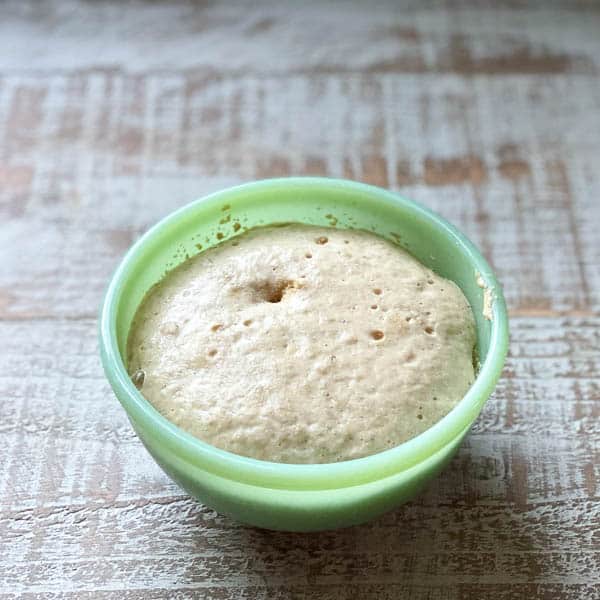
How to Make Baguettes
There are only about 20 minutes of actual hands-on time required for this easy baguette recipe. Otherwise, you’ll give the dough two separate short rises and then bake it off in the oven. Simple, fast, and you get two loaves for one effort — so you can stash one in the freezer for another day!
- Proof Yeast. Since we’re using dry active yeast (not instant yeast), you’ll need to soften the yeast in a small bowl with warm water and sugar before adding it to the dough. Let it sit for about 5-10 minutes until it looks a little bit foamy. Traditional baguette recipes don’t usually include sugar; however, the sugar here feeds the yeast, creates carbon dioxide, and helps the dough rise faster.
- Mix Dough. Mix together the dough using flour, salt, and yeast mixture. Add warm water until a soft dough comes together.
- Knead. Kneading the dough makes bread light, airy, and chewy by developing gluten. Strengthening the gluten strands gives your bread structure. Don’t worry — kneading dough is really easy!
- First Rise. Proofing bread is when you give the yeast time to do its work to help the bread rise. To proof bread, place the dough in a greased bowl and let the dough rest in a warm, humid environment until it doubles in size — about 45 minutes – 1 hour.
- Shape Baguettes. Divide the dough into two equal portions, and then shape each portion into a baguette loaf.
- Second Rise. Cover with lightly greased plastic wrap or towel; allow the loaves to rise until they’re slightly puffy, about 25-45 minutes.
- Slash Dough. When your dough is puffy, remove the cover and use a baker’s lame (a special curved blade), a razor blade, or a very sharp knife held at about a 45° angle to make three to five long lengthwise slashes in each baguette.
- Bake. Transfer the dough to a 450°F oven while at the same time carefully pouring boiling water into a cast iron pan on the bottom rack of the oven. The steam from the water will help create that super-crisp crust that’s a hallmark of an authentic French baguette. Bake for 15-20 minutes or until the loaves are a deep golden brown. Tap the top of the loaf lightly — it will sound hollow when it’s done.
How to Knead Bread Dough
To knead the dough by hand, flour the worktop, and then push, pull, and stretch the dough. When it’s properly kneaded, the dough should be elastic and smooth. If you’re fortunate enough to have a stand mixer, simply use the dough hook to knead the bread in the mixer. This is my preference because it’s hands-off — just let the machine run for about 4-6 minutes.
Before kneading:
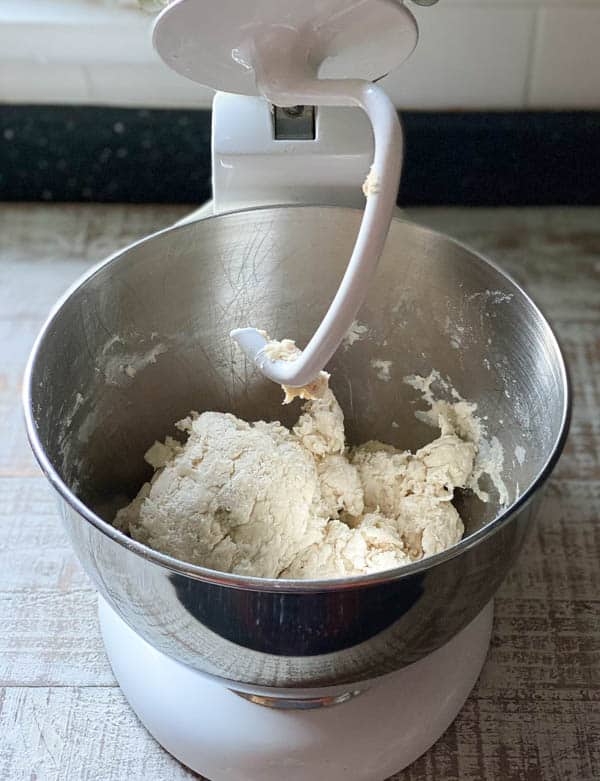
After kneading:
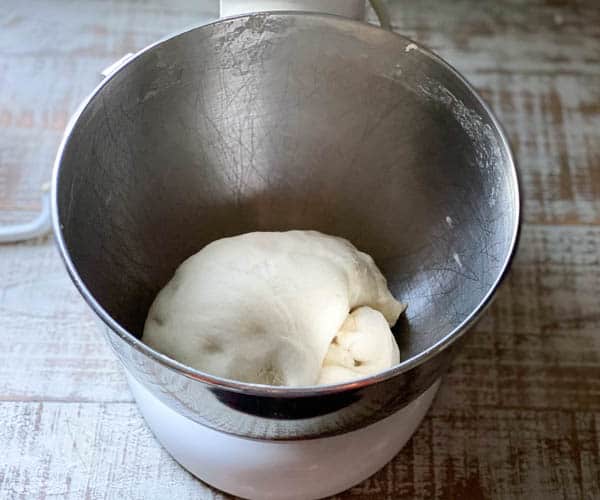
What does kneading baguette dough do?
Kneading bread dough is what helps create gluten strands. Gluten helps to create gas, which allows the bread dough to rise (proof) and built that fluffy texture once baked. And yes – it is possible to over-knead (and under-knead) bread. Over-kneading is easy to do when using a stand mixer, so watch for signs of overworked dough. Overworked dough will tear quickly and feel dense and tough to handle in the mixture. On the other hand, under-kneaded dough is floppy and loose, and you’ll struggle to form it into a ball. If your dough displays these signs, you’re in the clear to keep kneading.
What’s the best stand mixer for kneading bread dough?
If you’re shopping for a stand mixer for bread, check out this list of the best mixers for bread dough, which includes the one I use, the Kitchenaid 5-quart Artisan Series stand mixer. You can get it on Amazon from $379.99. Or, the Hamilton Beach 4 quart stand mixer is a good budget option that’s available at Walmart from $98.99.
How to Proof Bread Dough
If you’re having trouble proofing the bread, check the temperature of your kitchen. If your kitchen is a little too warm (above 75-80°F) or a little too cool (below about 65°F), it might be affecting the proofing stage.
If it’s on the warm side and you ended up with a dense loaf, it’s likely the bread was over-proofed — the yeast got too active and produced so much gas that the dough effectively popped like a balloon.
If it’s too cold, then the opposite might have happened. The yeast didn’t get a chance to become active enough and create enough gas to lift the dough. You should try letting it sit out a little longer.
Before proofing:
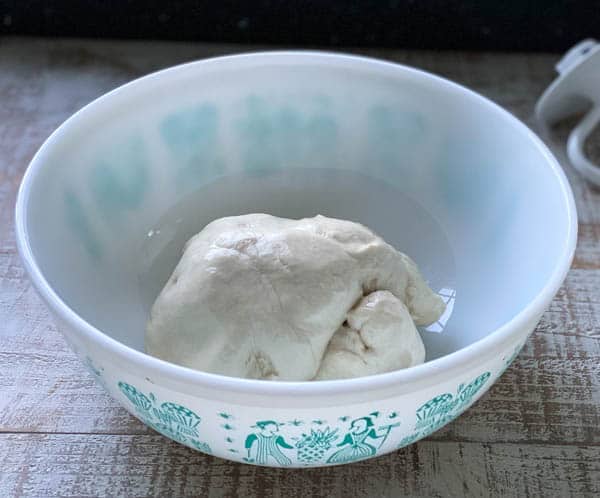
After proofing:
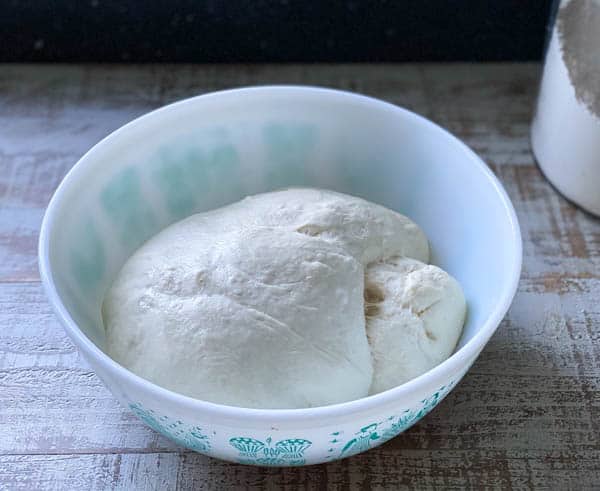
How long should you proof bread dough?
This recipe instructs you to proof bread dough in two increments for a total of about 2 hours, but it really depends on the temperature of the room where the bread is being proofed. The ideal room temperature for proofing bread is between 75°F and 80°F.
What happens if you over or under-proof the dough?
Overproofed dough is not impossible to save. You just have to test the proofing of the dough with the fingertip test, then de-gass the bread. Kneading and proofing bread is a delicate process, but this beginner-friendly method should make it easier on the novice baker!
How to Shape Baguettes
Punch the dough down and then divide into two equal portions.
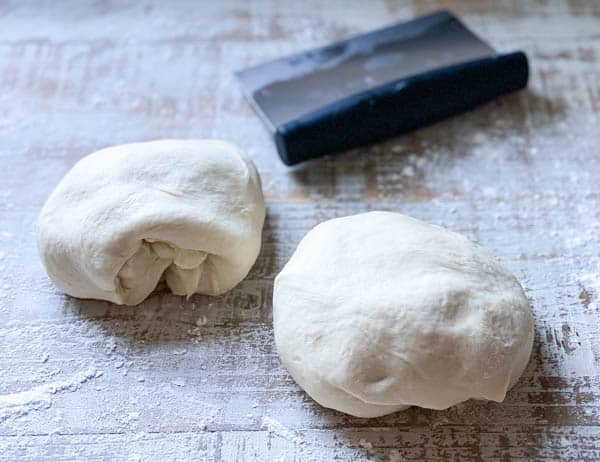
Working with one piece of dough at a time, flatten the dough slightly into small rectangles.
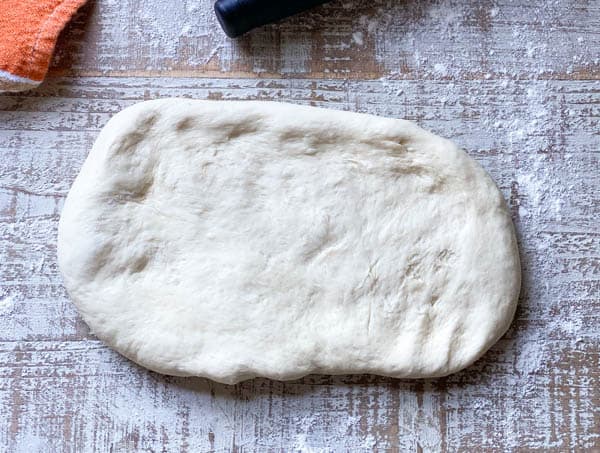
Fold one edge into the center, and seal the seam. Turn the dough around, and repeat on the other side. Repeat this process again, using your thumb and the heel of your hand to seal the seam as you go.
With the seam side down, gently roll from the center outwards, lengthening the dough into a log that’s about 12-14 inches long. Taper each end of the log slightly to create the baguette’s typical “pointy” end, if you like. Place the dough onto a cornmeal-dusted baking sheet, baking stone, couche, or baguette pan (or line with parchment paper).
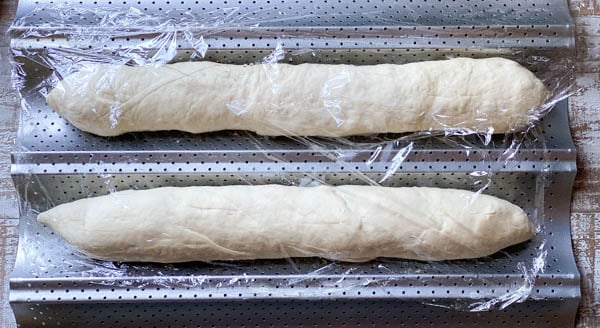
Tip: Watch this video for a great demonstration on how to shape a baguette.
Slash dough:
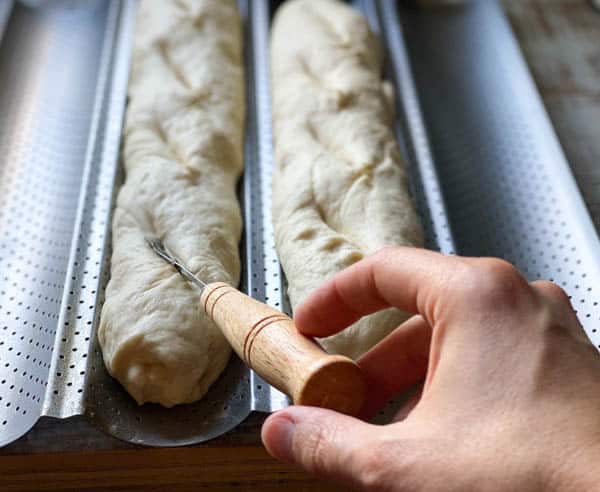
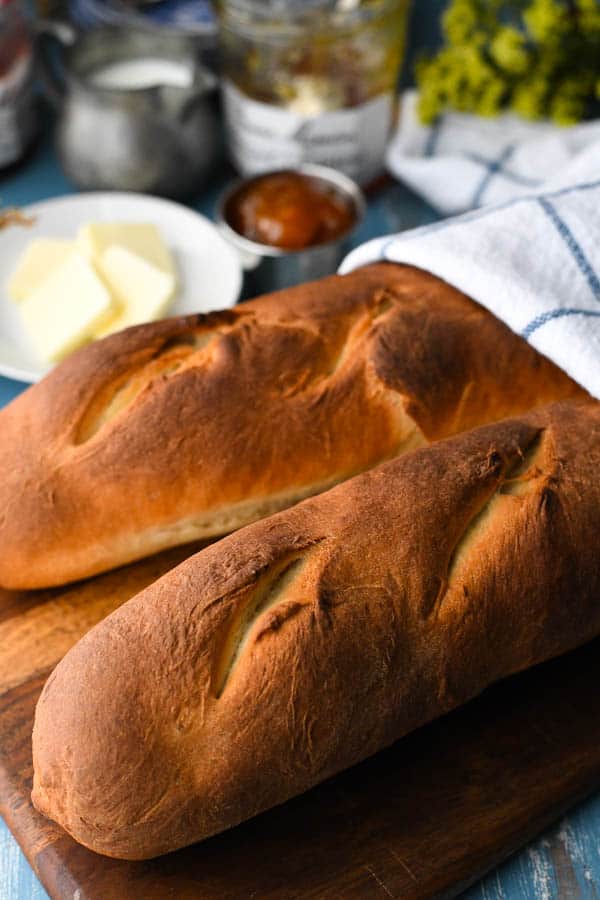
Serving Suggestions: How to Eat French Baguette
A versatile loaf of French bread has so much potential! We usually serve a fresh, sliced loaf as a side dish with bowls of soup or pasta for dinner. A crusty baguette is perfect for soaking up any extra broth or sauce on your plate, and you can also make homemade garlic bread with your loaves.
Use sliced, toasted baguette for appetizers like bruschetta or with cheeses and meats on a charcuterie board. At cocktail hour, pair the sliced baguette with crab dip, shrimp dip, or pimento cheese.
And finally, don’t forget that a ham and brie sandwich on baguette is amazing, as well as French toast made with day-old baguette or toasted baguette with butter and jam. Honestly, it doesn’t get much better than that!
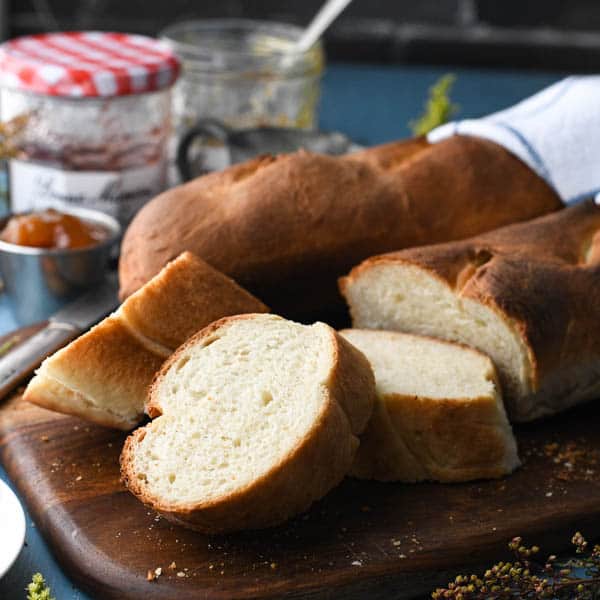
How to Keep Homemade Baguettes Fresh: Storage & Reheating
Baguettes are best when enjoyed within about 4 hours of baking. To store a baguette overnight, wrap it loosely in a paper bag and store at room temperature for 1-2 days. If it starts to get slightly stale, just toast it or reheat it in the oven.
While a French Boulanger may not agree, I like to freeze the extra baguette to enjoy at a later date. Just allow the loaf to cool completely, wrap tightly, and store in the freezer for up to 3 months. Thaw on the counter at room temperature, and then reheat in the oven just until warmed through.
How to Reheat
Preheat the oven to 300°F. Sprinkle the loaf with water, wrap it tightly in foil, and place it in the oven for 10 minutes. It should be perfectly warmed through!
How to Soften a Baguette
To soften a stale baguette, run it under warm water. Don’t soak through the bread entirely, but give it a nice coating of warm water. Place the damp bread directly on the rack in a 350°F oven for about 10-15 minutes.
Tips for the Best Baguette Recipe
- While I typically prefer bread flour in homemade bread, the baguette recipe works best with all-purpose flour. All-purpose flour is a blend of hard and soft wheat and is wonderful for making airier (less chewy) bread, like baguettes.
- Make sure that you use warm water when preparing the dough — not too hot and not too cold. You want the water to feel like warm bath water (about 110-115°F). If it’s too hot, you will kill the yeast; too cold, the yeast will not be activated.
- Adding steam to the bottom of the very hot oven will help give your baguette an extra-crispy crust. Don’t skip this step!
- I like a darker, crispier crust, so I bake my bread for about 18-20 minutes. If you prefer a softer, lighter crust on your baguette, you may only need to bake it for about 15 minutes. Check it early and pull it out when it reaches your desired color.
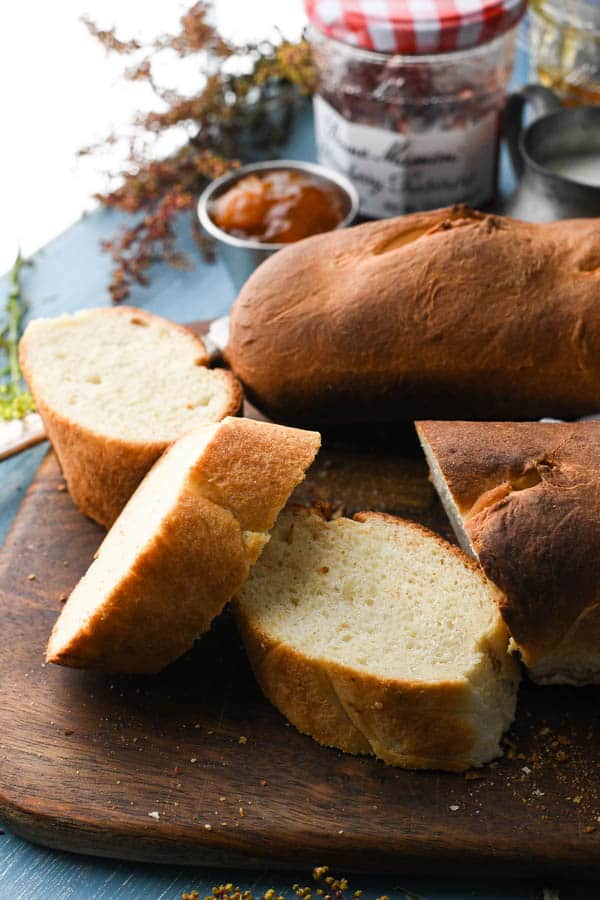
More Homemade Bread Recipes to Try
- White Bread with Milk and Honey
- Jalapeno Cheddar Bread
- Classic Farmhouse Oatmeal Bread
- Homemade Breadsticks
- Soft Homemade Dinner Rolls
- Homemade Crescent Rolls {Amish Butterhorns}
- No-Knead Dutch Oven Bread
- Soft Pretzels {Auntie Anne’s Copycat}
- Quick, No-Knead English Muffin Bread
- Easy French Baguette for Beginners
- Homemade Focaccia Bread
- Beer Bread
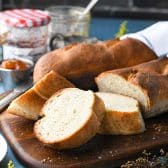
Homemade Baguette Recipe
Ingredients
Instructions
- Combine yeast, ½ cup of warm water, and sugar in a small bowl. Let rest for 5-10 minutes to activate the yeast. It should look a little bit foamy.
- In the large bowl of a stand mixer, whisk together flour and salt. Add the yeast mixture. Gradually (not all at once) add remaining ¾ cup of warm water and mix (or stir by hand with a wooden spoon) until a soft dough comes together in a ball. You might not need all of the water. If the dough is too sticky, you can add a bit more flour. It shouldn’t be sticking to the sides of the bowl.
- Once the dough comes together in a ball, knead with a dough hook or by hand until smooth and elastic – about 4-6 minutes. If the dough is sticking to the bowl or to your hands, add extra flour (one tablespoon at a time).
- Transfer the dough to a greased bowl. Turn to coat the dough with grease on all sides. Cover and let rest in a warm place until doubled in size, about 45 minutes.
- Punch the dough down to release the air.
- Cut the dough into two equal portions.
- Working with one piece at a time, flatten the dough slightly into a small rectangular shape. Fold one edge into the center, and seal the seam. Turn the dough around, and repeat on the other side. Repeat this process again, using your thumb and the heel of your hand to seal the seam as you go.
- With the seam side down, gently roll from the center outwards, lengthening the dough into a log that’s about 12-14 inches long. Taper each end of the log slightly to create the baguette's typical "pointy" end, if you like.
- Place the dough onto a cornmeal-dusted baking sheet or baguette pan. Cover with lightly greased plastic wrap; allow the loaves to rise until they're slightly puffy (but not doubled in bulk), about 25-45 minutes.
- Towards the end of the rising time, place a cast iron pan (or other non-glass oven-proof pan or bowl) on the lowest rack in the oven. Place another rack in the middle of the oven. Preheat oven to 450 degrees F. Bring 1 ½ cups of water to a boil.
- When your dough is puffy, remove the cover and use a baker's lame (a special curved blade), a razor blade, or a very sharp knife held at about a 45° angle, to make three to five long lengthwise slashes in each baguette.
- Transfer the dough to the middle rack of the 450 degree F oven, while at the same time carefully pouring the boiling water into the cast iron pan. Quickly shut the oven door. The steam from the water will help to create a crusty exterior on the bread.
- Bake for 15-20 minutes, or until the loaves are a deep golden brown. The bread should sound hollow when you tap it. Remove from the oven and cool on a wire rack.
Notes
- Recipe slightly adapted from Food Network.
- While I typically prefer bread flour in homemade breads, the baguette recipe works best with all-purpose flour. All-purpose flour is a blend of hard and soft wheats and is wonderful for making airier (less-chewy) breads, like baguettes.
- Make sure that you use warm water when preparing the dough — not too hot and not too cold. You want the water to feel like warm bath water (about 110-115°F). If it’s too hot you will kill the yeast; too cold and the yeast will not be activated.
- Adding steam to the bottom of the very hot oven will help give your baguette an extra-crispy crust. Don’t skip this step!
- I like a darker, crispier crust, so I bake my bread for about 18-20 minutes. If you prefer a softer, lighter crust on your baguette, you may only need to bake it for about 15 minutes. Check it early and pull it out when it reaches your desired color.












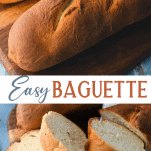
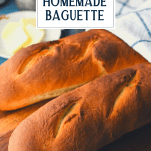


Hi, Blair! This is a great blog (post? whatever it’s called!)! I bake different breads. It’s fun to create such a basic food. And it’s better than mass produced commercial breads (OK, there are a few good ones out there). I love French bread and baguettes. I don’t always have the time to put into making the loaves that require all day (or into the next day) to produce. So this beginner recipe is perfect. I have used it many times. I thought your readers might like to see a positive feedback (and you, too, of course!).
I have a single loaf “pan” (made of pottery by a local potter), and it is rare that I will want 2 loaves. I cut the recipe in half and go to it. For a 2nd loaf, should I neec one, I have constructed a “pan” out of a couple layers of heavy duty aluminum foil. This rather than setting the loaf on a baking sheet – it wants to spread out too much for my liking. I will some day pick up another double loaf pan, but for now . . . . .
Great post for all those beginners!
That’s so great to hear, Larry! Thank you for taking the time to come back and leave a note (for me and for other readers). I’m so glad that you’re enjoying the bread and that you’ve been able to adapt it to suit your needs and the pan that you have. Take care!
Very delicious. Made it for French Onion soup. Since my stove is small, I open it up and spritz the stove with a spray bottle every 5 minutes. It came out crusty.
That’s a great tip, Laura. Thank you, and so glad that you enjoyed it!
First time I tried making baguettes and not only was this easy, they turned out beautifully. I made some fantastic garlic toast with this bread and can’t wait to dip it too. Thank you for sharing!
Sounds delicious! We’re so happy to hear this, Karen!
My husband and I do caviar every Friday night! Last Friday we didn’t have our usual baguette so I had to find a recipe and whip one up in less than three hours. This recipe was quick, easy and delicious! Thank you
That sounds like such a fun tradition! We’re so glad you found and enjoyed this recipe.